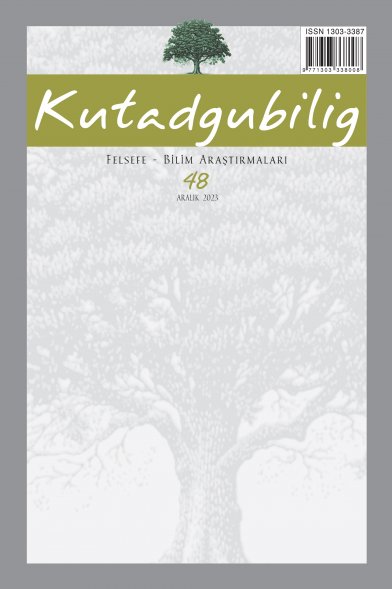SAYI, SONSUZLUK VE SÜREY VARSAYIMI: BİLGİNİN SINIRLARI ÜSTÜNE BİR ARAŞTIRMA
Cantor'un sonsuzlukla ilgili çalışmaları insan ile bildikleri arasında özel bir kesite karşılık gelir. Bu kesitte matematiksel bilgiye en önemli katkılarından biri olarak değerlendirilebilecek sonluötesi sayılar (transfinite numbers) yaklaşımı bulunur. Böylelikle Cantor farklı büyüklükteki kümelerden yola çıkarak tek bir sonsuzluğun olmadığını, sonsuzluğun çeşitli düzeyleri olduğunu gösterir. Cantor bu zeminde sürey varsayımını ortaya atar. Sürey varsayımı "gerçel sayılar ile tam sayılar arasında bir sonsuzluk bulunur mu?" sorusuna yanıtı olarak Cantor'un sezgisel biçimde bulunmadığı yanıtını vermesidir. Gödel, sürey varsayımının yanlış olduğunun kanıtlanamayacağını gösterir. Cohen ise doğru olduğunun kanıtlanamayacağını gösterir. Sonsuzluk düşüncesi üzerinden sürey varsayımının bizi bıraktığı nokta karar verilemezliktir. Bu çalışmanın amacı sürey varsayımı aracılığıyla insan bilgisinin sınır durumları olduğunu ortaya konulmasıdır. Anılan sınırlılığın kaynağı olan sonsuzluk düşüncesinin yapısının yeterince anlaşılması insan aklının olanaklarının ve sınırlarının saptanması açısından son derece önemli görünmektedir
AN INQUIRY ON LIMITS OF KNOWLEDGE: NUMBER, INFINTY AND CONTINUUM HYPOTHESIS
Cantor’s articles about infinity is a new approach to the limits of knowledge. This approach includes one of the most important progresses in mathematics, namely transfinite sets. Thereby Cantor shows us that there is not only one infinity but many others. Via transfinite numbers Cantor expresses continuum hypothesis which is the answer of the question “whether is there any set which has more elements than natural numbers and few members than real numbers?”. Cantor’s answer is no but he can not prove his answer. Later, Gödel proved that we can not disprove continuum hypothesis and Cohen showed we can not prove it. So the continuum hypothesis can never be proved that it is false and can never be proved that it is true. Consequently in this paper it is argued, continuum hypothesis teaches us that there are undecidable parts and limits of our knowledge. The source of this undecidableness is embodied in infinity. In order to understand why there are limits of knowledge, is a new and fruitfull way to discover new possibilities of reason
___
Barrow, John D.; The Infinite Book A Short Guide to the Boundless, Timeless and Endless, New York: Pantheon Books, 2005.Beth, W. Everth; The Foundations of Mathematics, Amterdam, North Holland Publishing, 1959.
Cantor, George; Contributions to the Founding of the Theory of Transfinite Numbers, çev. Philip E. B. Jourdain, New York: Dover Publications, 1915.
George Cantor; Gesammelte Abhandlungen mathematischen und philosophischen Inhalts, Berlin: Verlag von Julius Sprinder, 1932.
Cohen, P. J.; “The Independence of the Continuum Hypothesis.” Proc. Nat. Acad. Sci. U. S. A., 50, 1963, s. 1143/1148.
––––; “The Independence of the Continuum Hypothesis. II.” Proc. Nat. Acad. Sci. U. S. A., 51, 1964. s. 105-110.
Cohen, P. J.; Set Theory and the Continuum Hypothesis. New York: W. A. Benjamin, 1966.
Çitil, Ahmet Ayhan; Matematik ve Metafizik, İstanbul:Alfa, 2012.
Dalen, Dirk van: L.E.J.; Brouwer: Topologist, Intuitionist, Philosopher, London; New York: Springer, 2013.
Darrow, John; The Infinite Book: A Short Guide to the Boundless, Timeless and Endless, New York: Pnatheon Books, 2007.
Dauben, W. Joseph; “The Development of Cantorian Set Tehory”, From the Calculus to Set Theory 1630-1910, ed. I. Grattan-Guinness, New Jersey: Princeton University Press, 1980.
Gamow, George; One, Two, Three… Infinity: Facts and Speculations of Science, New York: Viking Press, 1947.
Gödel, Kurt; “On Formally Undecidable Propositions of Principia Mathematica and Related Systems I” From Frege to Gödel: A Source Book in Mathematical Logic, 1879–1931. ed. Jean van Heijenoort, Cambridge: Harvard University Press. 1967, s. 596-616.
––––; “What is Cantor’s Continuum Problem”, Philosophy of Mathematics: Selected Readings,
Paul Benacerraf, Hilary Putnam, N. J. Prentice-Hall:Englewood Cliffs, 1964, 176- 187.
Hilbert, David; “Mathematical Problems”, Bulletin of the American Mathematical Society, Vol. 8, No. 10 , 1902, s. 437–479.
––––; “On the Infinite”, Philosophy of Mathematics: Selected Readings, Paul Benacerraf, Hilary Putnam, N. J. Prentice-Hall:Englewood Cliffs, 1964, s. 183-200.
Nesin, Ali; Sezgisel Kümeler Kuramı. İstanbul: Nesin Matematik Köyü, 2013.
Maddy, Penelope; “Believing the Axioms I”, The Journal of Symbolic Logic, Vol. 53, No. 2. Jun.,1988, s. 481-511.
Nesin, Ali; Aksiyomatik Kümeler Kuramı. http://www.acikders.org.tr/pluginfile.php/572/ mod_resource/content/0/hafta_15.pdf,
Rucker, Rudy; Infinity and The Mind, London: Paladin, 1984
Tiles, Mary; The Philosophy of Set Theory, New York: Dover Publications, 2012.
Wittgenstein, Ludwig; Philosophical Grammar, çev. Anthony Kenny, Oxford: Basil Blackwell; Rush Rhees, 1974.
Zermelo, Ernst; “Investigations in the foundations of set theory” From Frege to Gödel: A Source Book in Mathematical Logic, 1879-1931. Ed. Jean van Heijenoort, Cambridge: Harvard University Press, 1967, s. 199–215.
- ISSN: 1303-3387
- Yayın Aralığı: Yılda 2 Sayı
- Başlangıç: 2002
- Yayıncı: Dergah Yayınları A.Ş.
Sayıdaki Diğer Makaleler
SOSYAL BİLİMLERİN EPİSTEMOLOJİK TEMELLERİ
VI. BAĞLAMSALCI BİR EPİSTEMİK GEREKÇELENDİRME TEORİSİ
Annis DAVİD B., Aydın Ekim SAVRAN
“ADALET”E “DOĞRULUK” DEMEK DOĞRU MUDUR?
ERNEST SOSA’DA HAYVANİ BİLGİ VE TEFEKKÜRİ BİLGİ
AHLAK ARGÜMANI, AHLAKİ ANLAŞMAZLIKLAR VE EVRİM TEORİSİ
К ГНОСЕОЛОГИИ РУССКОЙ МЕНТАЛЬНОСТИ: ФЕНОМЕН СУБЛИМАЦИИ ЯЗЫЧЕСКОГО МАТРИАРХАТА В ИМПЕРСКОЙ ИДЕЛОГИИ
SAYI, SONSUZLUK VE SÜREY VARSAYIMI: BİLGİNİN SINIRLARI ÜSTÜNE BİR ARAŞTIRMA
KANT’S CRITIQUE OF PURE REASON Methods and Intentions
SOSYAL EPİSTEMOLOJİ’DE İNANÇLARIN STATÜSÜ SORUNU
